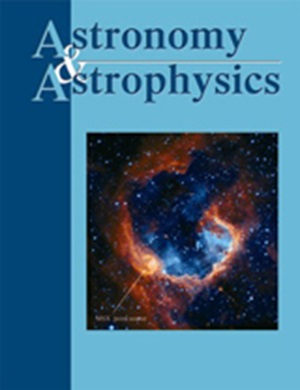全圆盘 Ca II K 光谱日线图分析
IF 5.8
2区 物理与天体物理
引用次数: 0
摘要
背景。研究太阳的长期活动和可变性需要了解太阳表面磁性过去的演变。自1892年以来在不同地点或多或少定期进行的全圆盘Ca II K观测档案可以作为此类信息的重要来源。我们利用以数字形式公开的所有 Ca II K 档案中的数据,包括一些尚未开发的 Ca II K 档案中的数据,推导出过去 12 个太阳周期中 plage 面积的演变情况。我们分析了来自 43 个数据集的 29 万多个全圆盘 Ca II K 观测数据,时间跨度从 1892 年到 2019 年。所有图像均采用自动程序进行处理,该程序可执行光度校准(如需要)和边缘暗化补偿。处理过程还考虑了影响许多图像的伪影,包括一些非常特殊的伪影,如京都和耶克斯数据中发现的亮弧。我们所采用的方法之前已在合成数据上进行过测试和评估,发现比文献中用于处理此处分析的数据子集的其他方法更准确。我们根据每个分析数据集生成了一个 plage 区域时间序列。我们发现,从各个档案中得出的海蚀面积之间的差异主要是由于在不同地点获取数据时所使用的中心波长和带通的差异造成的。我们根据经验对每个数据集的结果进行了交叉校准和合并,从而得出了一个综合系列的海域面积。我们采用了 "骨干 "方法将这些序列连接在一起。我们还证明,骨干序列的选择对最终的复合渔场面积影响不大。我们量化了由于中心波长的偏移而导致的在我们的处理过程中确定 plage 区域的不确定性,发现在历史数据中发现的平均条件下,其在日盘部分的不确定性小于 0.01。我们还发现,在观测过程中,多变的观测条件会在活动量最大时略微增大日斑面积。我们根据修正和校准过的历史和现代 Ca II K 图像,提供了迄今为止最完整的日珥区时间序列。从 1892 年起,在所有天数中的 88% 和从 1907 年起的 98% 都有了一致的 plage 区域。本文章由计算机程序翻译,如有差异,请以英文原文为准。
Analysis of full-disc Ca II K spectroheliograms
Context. Studies of long-term solar activity and variability require knowledge of the past evolution of the solar surface magnetism. The archives of full-disc Ca II K observations that have been performed more or less regularly at various sites since 1892 can serve as an important source of such information.
Aims. We derive the plage area evolution over the last 12 solar cycles by employing data from all Ca II K archives that are publicly available in digital form, including several as-yet-unexplored Ca II K archives.
Methods. We analysed more than 290 000 full-disc Ca II K observations from 43 datasets spanning the period between 1892–2019. All images were consistently processed with an automatic procedure that performs the photometric calibration (if needed) and the limb-darkening compensation. The processing also accounts for artefacts affecting many of the images, including some very specific artefacts, such as bright arcs found in Kyoto and Yerkes data. Our employed methods have previously been tested and evaluated on synthetic data and found to be more accurate than other methods used in the literature to treat a subset of the data analysed here.
Results. We produced a plage area time-series from each analysed dataset. We found that the differences between the plage areas derived from individual archives are mainly due to the differences in the central wavelength and the bandpass used to acquire the data at the various sites. We empirically cross-calibrated and combined the results obtained from each dataset to produce a composite series of plage areas. The ’backbone’ approach was used to bridge the series together. We have also shown that the selection of the backbone series has little effect on the final composite of the plage area. We quantified the uncertainty of determining the plage areas with our processing due to shifts in the central wavelength and found it to be less than 0.01 in fraction of the solar disc for the average conditions found on historical data. We also found the variable seeing conditions during the observations to slightly increase the plage areas during the activity maxima.
Conclusions. We provide the most complete so far time series of plage areas based on corrected and calibrated historical and modern Ca II K images. Consistent plage areas are now available on 88% of all days from 1892 onwards and on 98% from 1907 onwards.
求助全文
通过发布文献求助,成功后即可免费获取论文全文。
去求助
来源期刊

Astronomy & Astrophysics
ASTRONOMY & ASTROPHYSICS-
自引率
27.70%
发文量
0
期刊介绍:
Astronomy & Astrophysics is an international Journal that publishes papers on all aspects of astronomy and astrophysics (theoretical, observational, and instrumental) independently of the techniques used to obtain the results.
 求助内容:
求助内容: 应助结果提醒方式:
应助结果提醒方式:


